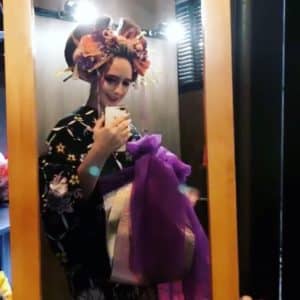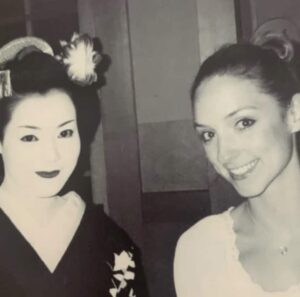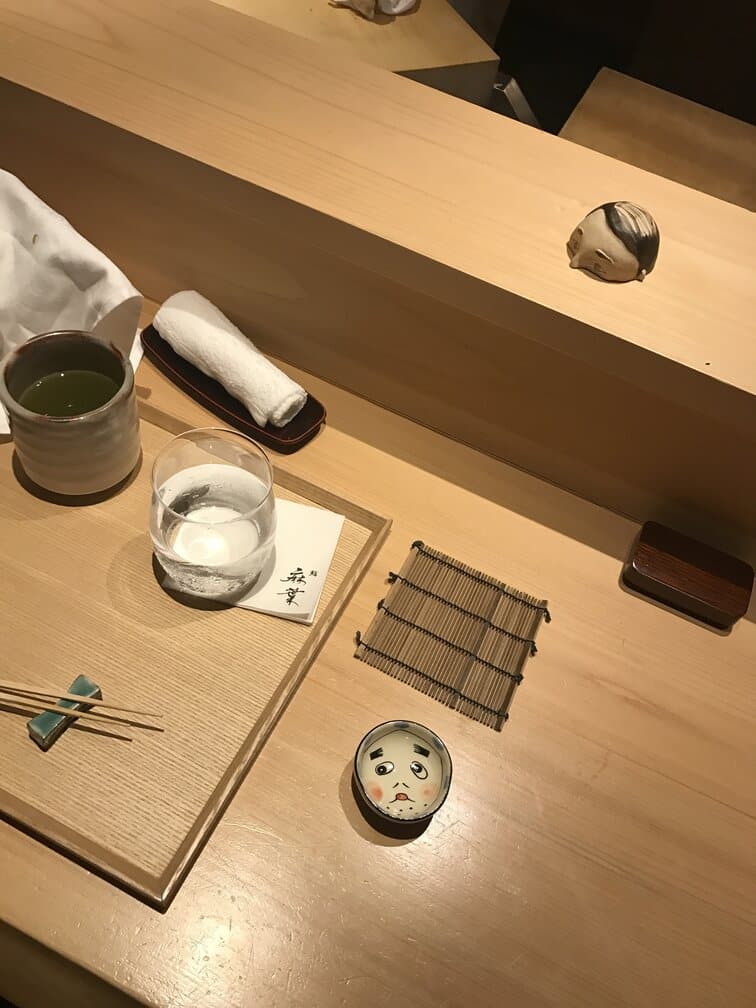
Please note that this isn’t a sake tasting tour type guide.
This article is written for parents who would like to choose a family-friendly restaurant in Tokyo – somewhere yummy for the whole family BUT THEY ALSO want to be able to sample some different types of Japanese sake with their dinner.
While at the kid-friendly Tokyo restaurants I have listed below – I recommend trying these types of Japanese sake.*
*Please note that I am not a sake connoisseur, by any means. These are the equivalent to me telling you “while in a pub in Australia, be sure to try a cider, a pale ale, a shandy, the local house white, a glass of bubbles, espresso martini, gin sour etc….* (so, in short, this is the “basic b” guide to trying sake… I just want to give you the basics and you can google around or talk to actual experts about actual sake information for people who actually know a lot more – and care a lot more – than I do.) If you’ve come here for tips on the kinds of rice in your sake selection – you’re talking to the wrong lady… and if I tell you that “this has orange undertones.. ” or something like … I’ve had TOO MUCH sake and I’m now completely just on a tangent and am making up complete rubbish. (!)
Okay – so the most important thing to realize is that the word “Sake” in Japanese – actually just translates to the word “liquor.”
So if you want to try sake as in rice wine etc… it’s easiest to say that you’d like to try “Japanese sake” (there are other variations of this but this is the easiest way to get directions to the part of the menu you want to see.) Especially if you mean the type that comes in the little baby-sized vase looking bottle with the little tiny cups.
The easiest way to try a few different types of sake while also having happy children in tow – is in an izakaya. This is a casual Japanese style restaurant/pub kind of deal. The food is all meant to be shared. You order lots of little dishes for the table to share and then you re-order something you loved and/or add on as you go – it’s not really the done thing to pour over the menu and make all food decisions in one go. The normal thing to do is probably sit down, choose a drink and get some edamame or fried chicken etc while you kind of settle in and have a look at the menu from there. The wait staff expect to see you many times over the evening as you refresh drinks and add to your selection of nibbles.
An easy way to start is to order a “sour” or a “chuhai”
At almost all izakaya in Japan, you’ll find a range of sours – they are written with the flavour + sour on the menu. Eg. Lemon Sour. Lime Sour. Plum Sour. This just means it is a mixed drink. The alcohol in a “sour” is shochu. Shochu is a hard liquor made from sweet potato, barley, rice, buckwheat and sugar cane. So a “Lemon Sour” is lemon flavouriing (like a cordial) with soda water and shochu.
A chuhai is a shortening of the two words shochu + highball. It’s basically the same as a sour but the term “sour” is more popular in restaurants. Most Japanese people expect a sour to be made fresh while a chuhai is like a pre-mixed drink (usually in a can sold at convenience stores.). Sours are usually a fruit flavour or fruit juice + a soft drink while chuhai allows for more pre-mix ingredient flexibility such as mixing softdrinks like coke or tea etc.
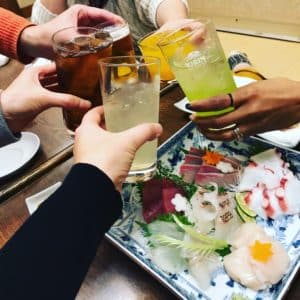
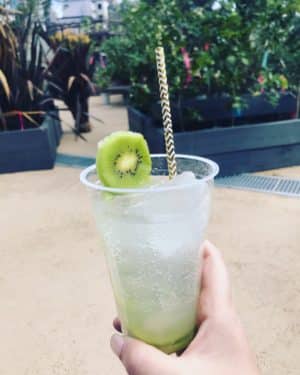
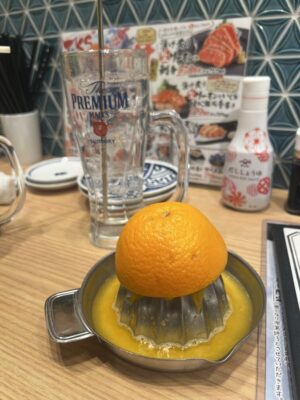
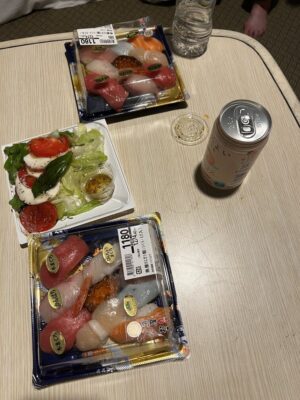
The drink is an alcoholic peach flavoured chu-hai.
Shochu can also be ordered on it’s own (it’s a hard liquor like vodka) and it’s usually ordered with a water or soda mixer. If you’re just having a shochu with water- ask for a mizu-wari. With soda? soda-wari.
*My friend @flying_foodlover. helped me out for some of these suggestions, by the way. As she ACTUALLY knows what she is talking about with this stuff *
For rice wine (Japanese sake), I recommend ordering Nihonshu. Nihonshu is served hot or cold. If you’d like to order it hot (my fave!)- please say you’d like to order atsukan. Understandably, it’s more popular in cooler months. Hot or cold, your nihonshu will appear in a little vase like jug with small cups (some restaurants will bring a tray of little cups and you choose your own.) As much as you may be tempted – it’s NOT a shot glass. You are meant to sip.
If you are dining with Japanese friends or colleagues – remember that no-one is ever meant to fill their own glass. Do it for them first. They will most likely offer to fill up yours for you too.
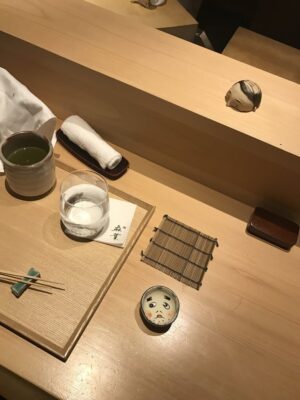
A lovely little sweeter sake you may like to try is Umeshu. Umeshu is a plum wine and is almost always served over ice. Appearance wise, it looks a bit like apple juice – but it definitely tastes alcoholic. It’s a little on the sweet and a little on the sour side. I, personally, can really only have one of these before I go back to another drink as it feels a bit like having sweets to me. Some restaurants make Umeshu-based cocktails.
Here are some restaurants where you can dine with children in Tokyo where you can also try some different types of sake..
GINZA
Japanese izakaya & hot pot restaurant Iinoji is also a fabulous place to go to eat Japanese food as a family. As with almost all izakayas in Japan, the idea is that you order lots of small dishes to share and then order more as you go (of the same things you enjoyed or different dishes.) I recommend ordering the wagyu beef sukiyaki bowl (this dish is actually designed to be one per person,) the sweet potato or shrimp tempura, edamame, wagyu sukiyaki croquette, the grilled miso rice ball. You can see the full Iinoji dinner menu here.
You can see the full lunch menu for Iinoji here.
This restaurant welcomes babies and children. They also have space for strollers. This is a wonderful place for parents to try different types of sake (hot and cold.) They accept most major credit cards. There is a 550 yen per person cover charge on top of your bill when you dine after 5pm. When eating lunch here, I recommend budgeting for 2000 yen per adult and more like 6000 yen per adult for dinner. You can make a reservation via table check here. When making a reservation, you can choose to sit at a table at a counter, at a counter or at a booth. I don’t recommend a counter seat with kids – with smaller kids, get a booth and seat kids on the inside so they can wriggle a bit more and colour etc.
To get to Iinoji, take a train to Mitsukoshimae Station or Shin-Nihonbashi Station (you can walk underground from both stations directly to the restaurant.) It is 14 mins walk from Tokyo Station or 11 mins in a taxi from Ginza Station.
IINOJI
日本橋室町3-2-1 コレド室町テラス 1F
GROUND FLOOR, COREDO MUROMACHI TERRACE, 3-2-1 NIHONBASHI MUROMACHI
OPEN EVERYDAY FOR LUNCH 11AM-3PM
OPEN EVERYDAY FOR DINNER 5PM-10PM (UNTIL 11PM ON FRIDAYS)
If you’re feeling like some Korean BBQ for dinner (or lunch!) (aka Yakiniku) there is a family friendly restaurant just 5 mins walk from Ginza Station (2 mins from Yurakucho Station, 1 min walk from Ginza Itchome Station, 5 mins from Higashi Ginza Station, 3 mins from Kyobashi Station.) The restaurant is called Yakiniku Ushigoro, Ginza. This is a special dinner kind of restaurant (with “special dinner” prices too.) You will be seated at a table with a grill in the middle and you barbecue your own thin slices of meat to then dip in different marinades. It’s a great interactive experience with kids. This restaurant welcomes children and babies. This restaurant has a beautiful view over the city at night. They have an English menu and accept most major credit cards. This restaurant is very popular so you will need to make a reservation. You can make a reservation for Yakiniku Ushigoro Ginza online in English here. You can also see the food menu at Yakiniku Ushigoro Ginza online here. And the Yakiniku Ushigoro Ginza Seasonal Menu here. This is also a wonderful place for the grown ups to taste different types of sake. If you decide to visit Yakiniku Ushigoro Ginza for lunch you can see all of their lunch courses here.
At lunch time, I would budget for 8000 yen per adult and more like 15, 000 yen for dinner (this restaurant has won awards for fabulous service and high meat quality.)
This restaurant has space to store strollers while you dine and ALSO space to pull the stroller up next to the table by removing a chair.
YAKINIKU USHIGORO GINZA
中央区銀座1-8-19 キラリトギンザ 7F
7F KIRARITO GINZA BUILDING, 1-8-19 GINZA, CHUO-KU
OPEN MON & TUES 5PM-11:30PM (LAST ORDERS 10:30PM)
OPEN WED-FRI 11:30AM-3PM (LAST ORDERS 2:30PM)& 5PM-11:30PM (LAST ORDERS 10:30PM)
OPEN WEEKENDS 11:30AM-11:30PM (LAST ORDERS10:30PM)
CLOSED FOR THE NEW YEAR HOLIDAYS
THE TOKYO STATION AREA
Family-friendly izakaya just 10 mins walk from Tokyo Station
For lunch or dinner, I recommend dining at Japanese izakaya restaurant Nihonbashi Ichi no Ichi no Ichi.
Like most izakaya in Japan. The idea is that you order lots of small dishes and share – and then order more of the same or more of other small dishes as you go. It’s a great way for everyone to try new foods. At dinner time, I recommend ordering the dashi-maki (rolled Japanese omelette, cooked with a little fish broth), fried chicken, crab miso and charcoal grilled wagyu beef. See the full english dinner menu here.
While for lunch (Sat and national holidays only) , I recommend ordering the tempura or the sukiyaki lunch set. See the full lunch menu here.
This is also a fabulous place for the adults at the table to try lots of different hot and cold sake. This restaurant welcomes children. When you are making a reservation (use tablecheck link here) you can ask for seats on the terrace, in the booth or at a table (I recommend the booth if you have smaller kids as you can put them on the “inside” and they can do some colouring or stand up sometimes on the seats (with shoes off “) if they need to.
I recommend budgeting 6000 yen per adult at dinner time and more like 3000 yen per adult for lunch. This restaurant accepts most major credit cards.
The entire restaurant is non-smoking.
Nihonbashi Ichi no Ichi no Ichi is 1 min walk from exit B9B of Nihonbashi Station. It’s 10 mins on foot if you’re coming from Tokyo Station.
If anyone in your family studies Japanese – take note of the address and try and work out where they got the name from…
NIHONBASHI ICHI NO ICHI NO ICHI
日本橋1-1-1 国分ビルディング 1F
GROUND FLOOR, KOKUBU BUILDING, 1-1-1- NIHONBASHI
OPEN WEEKDAYS 5PM-11PM
OPEN SAT & NATIONAL HOLIDAYS 11:30AM-3PM & 5PM-10PM
CLOSED SUNDAYS
EBISU
If you would like to try Omakase Sushi Menu that also allows children, I recommend jumping on public transport or a cab for 10 mins (approx 1500 yen by cab) to Sushi Asahi in Gotanda. Sushi Asahi, Gotanda
Sushi Asahi welcomes families. Omakase course are either side of 15,000 yen and children will also need to order a course (lunch courses are more liken 5000-8000 yen though.) They accept most major credit cards. There are 6 seats at the counter and 24 table seats. Sushi Asahi is 3 mins walk from the East Exit of Gotanda Station. The entire restaurant is non-smoking. For adults, this is an excellent place to try a sushi and sake pairing menu. Reservations can be made via table check (deposit required.) If dining here with children isn’t an option for you, check out the Sushi Asahi incredible INCREDIBLE takeout sushi options here (can also be ordered by tablecheck (easisest if you’re clicking through on their site though with the help of a Japanese speaker.)
SUSHI ASAHI, GOTANDA
品川区東五反田1-11-8 大阪屋ビル 1F
GROUND FLOOR, OSAKAYA BUILDING, 1-11-8 HIGASHI-GOTANDA, SHINAGAWA
OPEN WEEKDAYS FOR LUNCH 11:30AM-2PM
OPEN EVERYDAY 4:30PM-11:30PM
SHIBUYA
This is a standing sushi bar in Shibuya. This is an easy way to quickly try a few (not the kind of place where you linger for ages with kids though as it’s a standing bar situation.)
If you don’t have a stroller (no room) and have kids old enough to stand still and be reasonably quiet while they eat, you might want to pop into Uogashi Standing Sushi Bar in Shibuya. This is a walk-ins only restaurant. It is non-smoking. And, as the name suggests, you stand while you eat. Uogashi accept most major credit cards. It is just one minute walk from Shibuya Crossing. It’s not a Michelin star restaurant by any means, but it is a great place to try some new kinds of sushi and sashimi without breaking the bank. I would budget for about 1000 yen per person for a meal here or half that if you just want to try a few things.
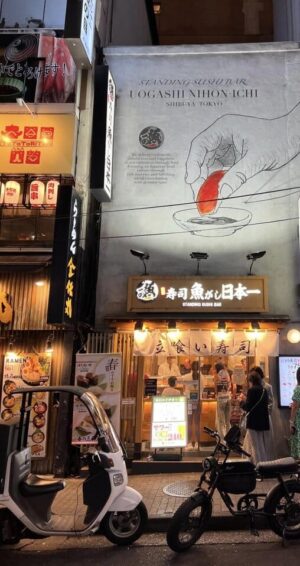
It’s a great spot for bigger kids to try their Japanese skills actually as the chef is right in front of them . They can try “Ebi kudasai” (Prawn, please.) “Aburi Toro Salmon kudasai” (flame-seared salmon sushi please)
Parents can also try out some sake!
This place is small so it would be hard to dine here with more than 3-4 people and still remain all together.
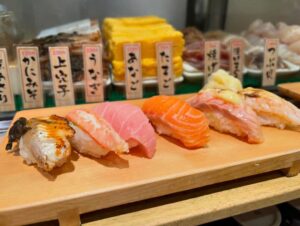
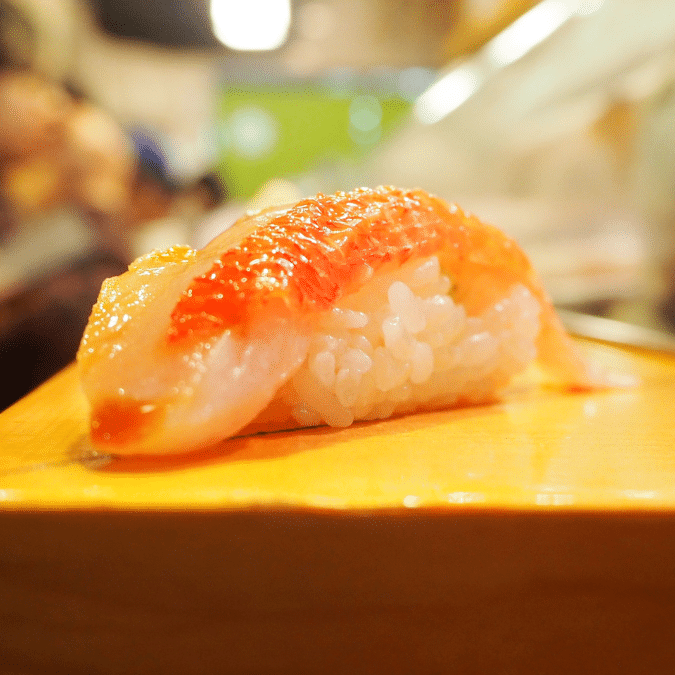
UOGASHI NIHON TACHIGUI SUSHI
渋谷区道玄坂2-9-1
2-9-1 DOGENZAKA, SHIBUYA
OPEN EVERYDAY 11AM-11PM (LAST ORDER AT 10PM)
UENO
How about Yakitori for lunch or dinner? Yakitori (grilled and chargrilled chicken skewers) restaurant Torimitsukuni is just 1 min walk from Ueno Station. This restaurant welcomes young families. This restaurant is entirely non-smoking and they also accept most major credit cards. In terms of budget, I would set aside 1500 yen per adult at lunchtime and more like 4000 yen at dinner time. Unfortunately it is only in Japanese but you can see the menu online with pictures here – and you can put it through Google translate if you like.
If you are gluten free in Japan- Yakitori can be a good option. But be sure to ask for it to be prepared with salt, not tare (sauce/marinade as “tare” is made using soy sauce.)
TORIMITSUKUNI YAKITORI & SAKE RESTAURANT
台東区上野公園1-54 B1F
BASEMENT FLOOR, 1-54 UENO-KOEN, TAITO-KU
OPEN MON-THURS 11:30AM-2PM & 5PM-10:30PM
OPEN FRI 11:30AM-2PM & 5PM-11PM
OPEN SAT 11:30AM-2:30PM & 4PM-11PM
OPEN SUN & NATIONAL HOLIDAYS 11:30AM-2:30PM & 4PM-10:30PM
SHINJUKU
For dinner with kids in an Izakaya in Nishi-Shinjuku, then I recommend going to Kanagari. Reservations required and this is the kind of restaurant where you order lots of little dishes and share. Kids are welcome but it isn’t the kind of place you’d take an iPad etc. so if your kids aren’t great at sitting at the table and trying new foods, this might not be the place for you. The style of dining is Robatayaki. I would expect to pay around 5000 yen per adult to dine here. There is a 660 yen service charge per person (and, as a thank you, every customer is given an ootoshi -which you don’t have to eat if you don’t want to.) This is a great place for Mums and Dads to try some different types of sake.
Please be aware that smoking is allowed in some sections of the restaurant.
Kamagari accepts credit cards. It is 9 mins walk from JR Shinjuku Station.
KANAGARI
新宿区西新宿7-16-12 新YSビル 3F
3RD FLOOR, SHIN-YS BUILDING, 7-16-12 NISHI-SHINJUKU, SHINJUKU
OPEN 5PM-11PM – OPEN FROM 4PM ON WEEKENDS (LAST ORDER 10PM)
You may like to make a reservation at this vegan restaurant in Shinjuku.
5 mins walk walk from Shinjuku Gyoen Gardens is completely vegan restaurant Mer Umi to Geijutsu no Ie. You MUST make a reservation in advance here. Children are welcome. At lunchtime, I recommend budgeting for approx 3000 yen per adult and more like 8000 yen at dinner time. They accept most major credit cards here. If you have a stroller, let the staff know and they will help you up to the 2nd floor. They have an English menu here. Please note that diners must not wear any perfume of cologne here (it messes with the scents and flavours at the restaurant.) This is a great spot to try different types of sake. The entire restaurant is non-smoking. There is a service charge for each diner here of 500 yen (to say thank you for this – diners are given an otoshi – small appetiser- when they sit down. If you don’t want to eat it, that’s fine. Just leave it on the table.)
MER UMI TO GEIJUTSU NO IE
OPEN FOR LUNCH (WEEKDAYS ONLY) 11:30AM-4PM (LAST ORDERS AT 3PM)
OPEN FOR DINNER 7PM-MIDNIGHT
CLOSED WEDNESDAYS
See other things to do in Shinjuku with kids here.
AKASAKA/ROPPONGI
Another izakaya pub that is VERY casual (a little rowdy but in a good way) and reasonably priced is Uoshin – which is located close to Tokyo Midtown Department Store.
You will knock elbows with the locals and can also try lots of different types of food.
Ask about their nomihodai (all you can drink) and food course which costs 5000 yen per person for a few hours. The course is pre-determined by the chef so if you’d rather have a say – maybe go for just normal a la carte instead.
I recommend ordering the assorted tempura, a sashimi platter, a lemon sour ( sake mixed with lemon soft drink) and crab croquettes. Soooo yummy.
The place gets REALLY hot so have a thin layer on underneath. Also wear easy on and off shoes incase your seats are on the tatami (although you can specify when you book.)
The restaurant is surrounded by red, blue and white lanterns. You can’t miss it.
Warning: the restaurant is not smoke free. There is a smoking and non-smoking section but…. smoke doesn’t exactly stay where it is told to, right?
They have child-friendly cups, plates and spoons etc.
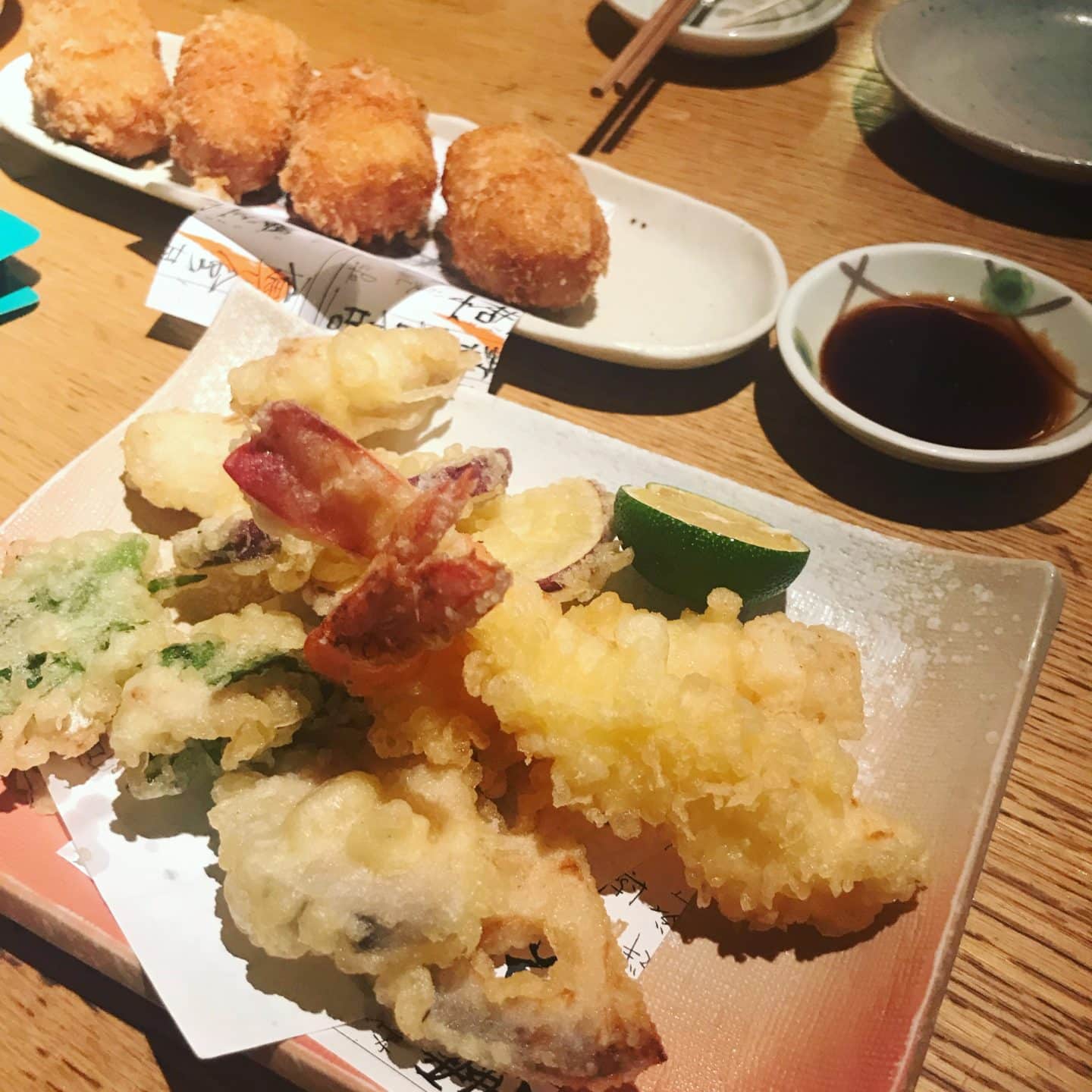
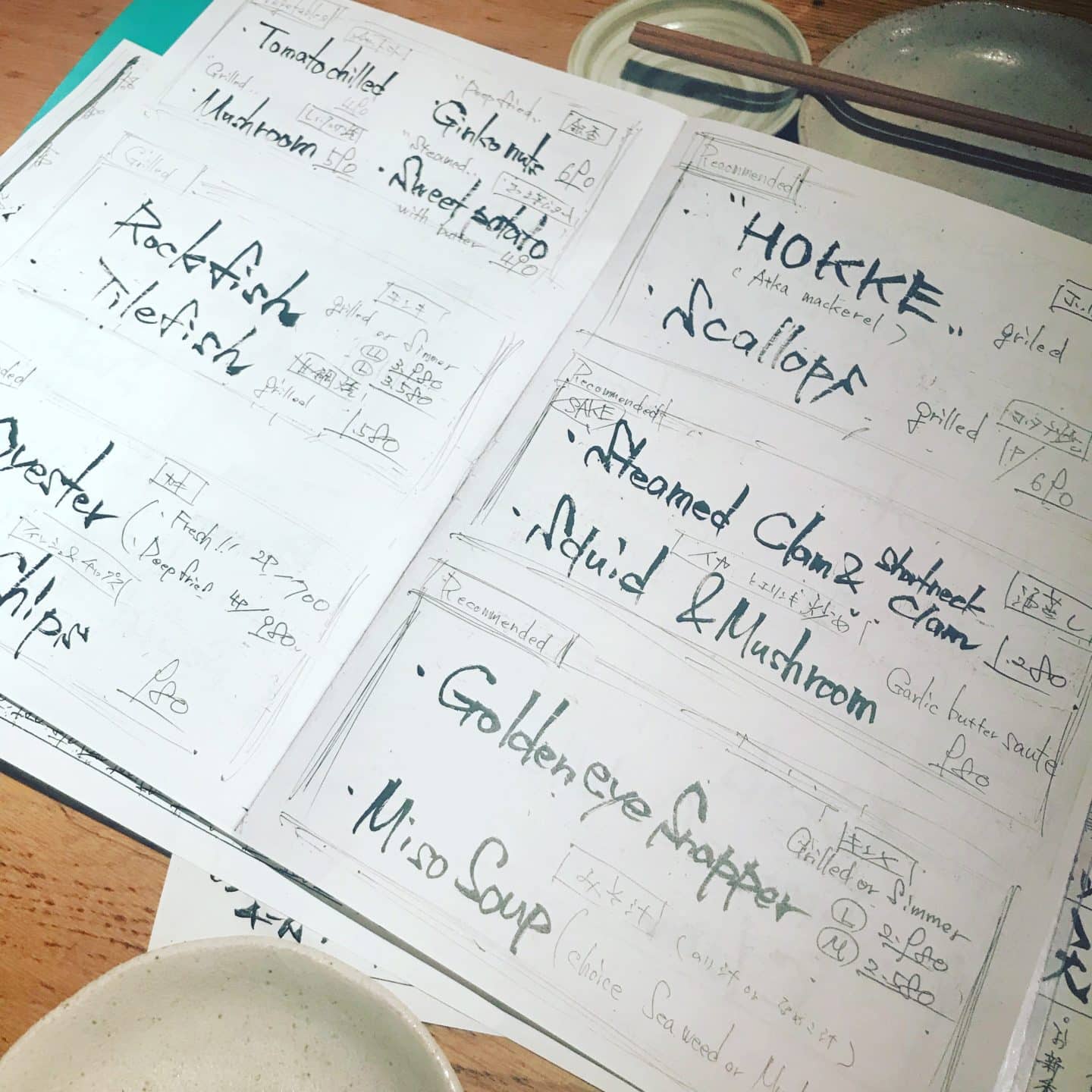
UOSHIN NOGIZAKA
港区赤坂9-6-32
9 -6-32 AKASAKA, MINATO-KU
WEEKDAY LUNCH 11:30AM – 2PM
WEEKDAY DINNER 5PM – MIDNIGHT
WEEKENDS AND PUBLIC HOLIDAYS 4PM – 11PM
See here for other things to do with kids in Roppongi with kids.
ASAKUSA
Lunch and Dinner Suggestion in Asakusa- gluten free tempura
This restaurant only seats 10 so you need to make a reservation. Also, this restaurant only welcomes children 6 years and older. The restaurant is called Tempura Asakusa Sakura. They accept credit cards. They also have an English menu. Tempura Asakusa Sakura is well known for delicious gluten free tempura and also delicious gluten free wagyu beef tempura. See the full Tempura Asakusa Sakura menu here. This is the Tempura Asakusa Sakura instagram. The entire restaurant is gluten free – the tempura is made with rice flour. There is even a Wagyu & Tempura Bowl.They even home make their own gluten free soy sauce. This is also a great place to try different types of sake.
This restaurant is opposite the A4 Exit of Asakusa Station.
At lunch time I would budget for 3000 yen per adult but more like 7000 yen at dinner time.
TEMPURA ASAKUSA SAKURA
台東区雷門2-18-16 THE CITY 浅草雷門 7F
7TH FLOOR, THE CITY ASAKUSA KAMINARIMON BUILDING, 2-18-16 KAMINARIMON, TAITO-KU
OPEN EVERYDAY MIDDAY-8PM (LAST ORDERS 7:30PM)
See here for other things to do in the Asakusa area with kids.
Tokyo Yakiniku Heijoen Asakusa Sohonten was founded in 1970. The restaurant is beautiful and it’s a great place to try A5 Grade Wagyu. Eat table has it’s own grill. If you are gluten free, ask for lemon with the meat for dipping rather than using the marinades provided. They accept most major credit cards. I recommend budgeting for 2000 yen per adult lunch and more like 7000 yen at dinner time.
They welcome children here. They are happy to store strollers for you while you dine. The restaurant is non-smoking but there are enclosed smoking rooms on each floor. This is a great place for parents to also try different types of sake. Ask your hotel to make a reservation on your behalf.
They are 3 mins walk from Asakusa Station or 1 min walk from the Ninja & Samurai Museum in Asakusa. You can also organise for a small birthday cake with your birthday name written in chocolate on top if it’s your birthday.
TOKYO YAKINIKU HEIJOEN ASAKUSA SOHONTEN
台東区雷門1-15-10
1-15-10 KAMINARIMON, TAITO-KU
OPEN 11:30AM-11PM (LAST ORDERS AT 10PM)
KOENJI
Tachi Sushi Yokocho Koenji is a fabulous option. It is also in the PAL Shotengai Shopping Arcade Street in Koenji. They welcome children here and the restaurant gives the most beautiful traditional Japanese restaurant vibes. They have more than 65 different sushi plate options. Because it’s a standing sushi bar, it’s a great place to try a few things without having to commit to a full meal. There are a few tables. Ask your hotel to make a reservation on your behalf and you can request a table if you like- there are limited options though. All 65 sushi plate options are between 130-400 yen. For kids who aren’t feeling super adventurous right away, you can order just cooked egg sushi, fried shrimp sushi, cooked egg on its own. They also have sushi platters. Their takeout sushi platters are incredibly beautifully presented – so gorgeous. They do take reservations and they also accept most major credit cards. This restaurant is 3 mins walk from Koenji Station. If one parent wants to venture out in the evening to try some sushi and maybe meet some locals – this is great spot. This is a fabulous way to try different types of sake and other alcoholic drinks in Japan – while also being in a family-friendly spot.
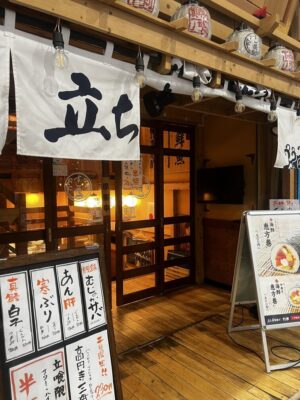
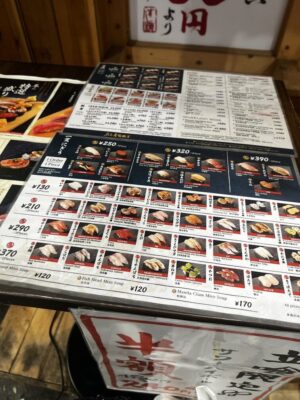
TACHI SUSHI YOKOCHO KOENJI
杉並区高円寺南4-25-9 三治ビル B1F
BASEMENT FLOOR, 4-25-9 KOENJI-MINAMI, SUGINAMI
OPEN MON-WED MIDDAY-3PM & 5PM-10:30PM
OPEN THURS-FRI MIDDAY-3PM
OPEN SAT 11:30AM-11PM
OPEN SUN 11:30AM-10:30PM
See here for other family-friendly suggestions in Koenji


